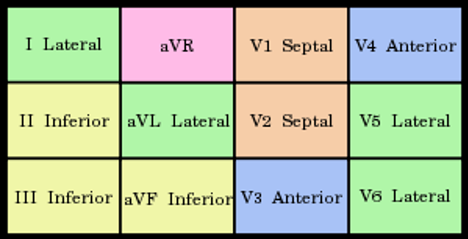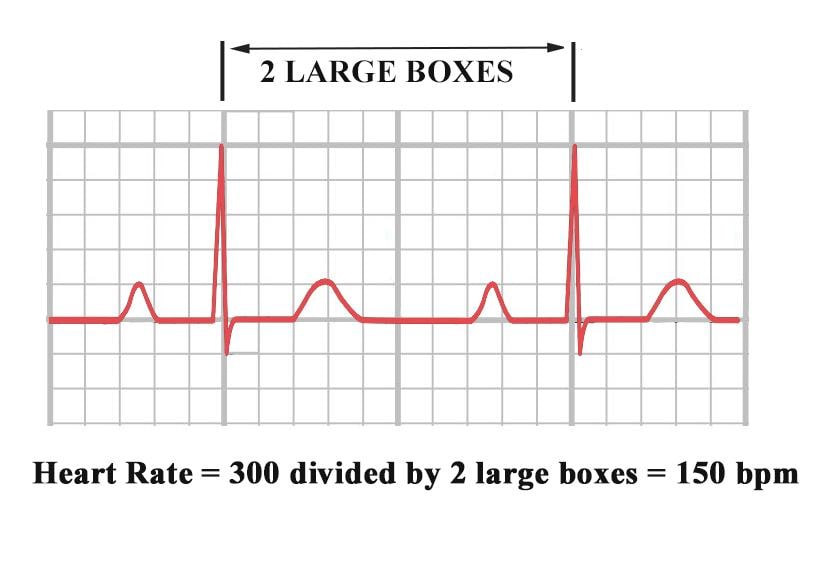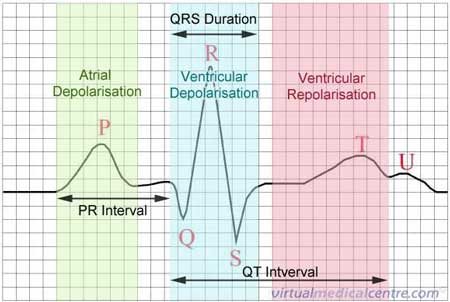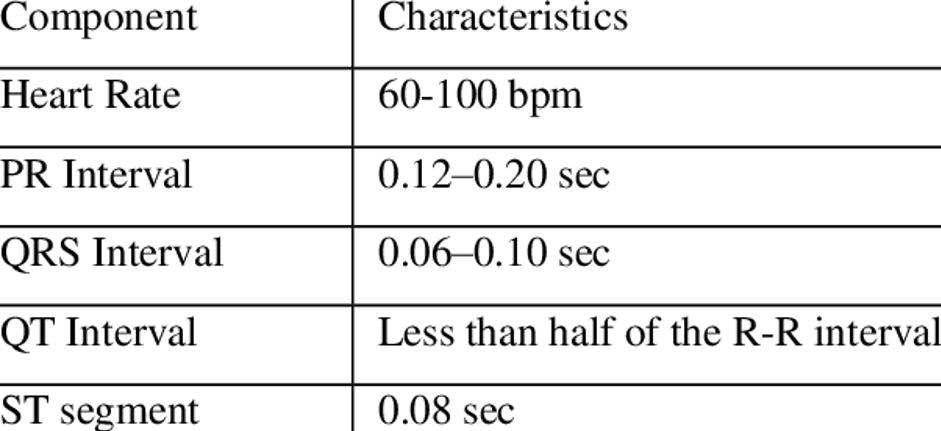Order of Ways to Read an Ecg
How to Read an ECG
-
The video to a higher place and article below share different information. Listen and read to both to go the most out of this mail service!
-
The ECG tin be a formidable foe for the PA educatee. In my early days working on the ambulance, gaining hours to apply for PA schoolhouse admission, information technology seemed very like shooting fish in a barrel. We would transfer the patient to a STEMI heart if nosotros saw ST height on the newspaper, but across this, I did not know much more. During PA schoolhouse, I struggled with how to read an ECG. Questions that students ask usa commonly are what is the normal ECG pattern? Equally my ECG learning increased, I realized all of the nuances and abnormalities that little piece of newspaper can reveal. Today, we will review a systematic approach on how to read ECG strips, starting with the basics.
The normal physiology
Similar many of the other of import topics in medicine, we accept to learn the normal office and structure of organs prior to studying the diseases. For today'south article, we will focus entirely on the normal portions of an ECG, saving the pathology and complicated life-threatening atmospheric condition for later, as books have been written on specific ECG findings.
So, where do nosotros offset?
The offset pace to understanding an ECG is thinking most the why behind the ECG. This is the start stride that helps united states of america assure nosotros are reading information technology properly and obtaining the correct diagnosis. For example, on the occasion that I club an ECG in principal care, I begin to ask myself:
- What am I looking for?
- What are the possible findings that may support my diagnosis?
- What are the findings that would betoken abroad from my diagnosis?
ECG for pre-op and in the ED
If it is for a pre-operative clearance, what are the findings that would warrant cancellation of the surgery. If you are in the ER, what are the findings that you can't beget to miss?
Narrowing the differential
By thinking about what we might expect and the symptoms the patient has, it allows us to help narrow down our findings, merely this is non the end all be all. We must consider many dissimilar outcomes, options, or findings that might be present on our ECG.
Get-go rules for ECG analysis
The first rules for our ECG analysis are, to always be considerate of what the patient tells you while maintaining an open mind and a broad differential. Exist open to finding things that you might not have been looking for and may non support your preliminary diagnosis! Medicine will ever surprise you.
Don't let the auto practice your chore….
An additional pearl before fifty-fifty beginning to read the ECG is to avoid simply gravitating to whatever the auto read out tells us. This can be tempting and is certainly the easier option, especially when you have an urgent care waiting room full of coughing patients, but this is dangerous and incorrect to do. The machine knows Cypher most the patient. It'south zero more a auto and does non take into account the patients signs and symptoms. Their appearance, and what the patient is telling you.
Comprehend the "diagnosis" read by the machine
Whatsoever medical assistant or LPN who has worked with me at urgent care or family practice knows that I get upset if they put the ECG in front end of me and say "Yeah, looks similar he has A-Fib". That's not what I want to hear. When an ECG is put in front of me, I immediately cover the machine's report. Information technology's my responsibleness to read the ECG.
Understanding what the ECG is telling united states of america
Once nosotros accept an ECG in forepart of us, the first stride is agreement what we are looking at. In many practices, we will be looking at a 12 lead ECG, which is a measure of the eye'south electrical conduction system, as energy flows through the heart. On a plane, the diverse leads correspond to different areas of the heart, each with a different outlook based on their location. For PANCE prep, the boards love to ask us what leads are associated with which part of the middle.

The center rate - regular rhythm
Prior to taking a look at the different components of the ECG, we should probably effort to figure out how fast the heart is chirapsia. I of the almost famous books of all fourth dimension, "Rapid Interpretation of EKGs" by Dale Dubin 1000.D., tells u.s.a. to look at the R wave start. The R wave is the tallest part of the ECG. The R wave typically falls on the darkened portion of a big box of the ECG. Past seeing how often an R wave is present, nosotros can easily determine how many beats are nowadays, based on the time respective to each large box.
For example, y'all tin calculate the eye rate by dividing the number of large boxes between two successive R waves into 300. If the interval between two QRS complexes is two big boxes, then the rate is 150, because 300 ÷ 2 = 150 bpm.

The heart rate using the "300-150-100…" method
In this case, if nosotros have an R wave higher up at the commencement and then immediately another R wave at the "300 mark", the rate is roughly 300. Woops, too fast. With each corresponding next dark line, the rate gets slower and slower. This allows us to count the QRS complexes very quickly and become a good estimate of how fast the charge per unit is.

300, 150, 100, 75, 60, 50, 43, 37, 33
The heart rate - irregular rhythm
If the middle rate is irregular, count the number of QRS complexes on the ECG and multiply by 6 to obtain the boilerplate eye rate. The ECG paper will bear witness a period of 10 seconds. Therefore vi x 10 = threescore seconds.
Prior to taking a await at the different components of the ECG, nosotros should probably try to figure out how fast the heart is beating. Ane of the about famous books of all time, "Rapid Interpretation of EKGs" past Dale Dubin Chiliad.D., tells u.s. to look at the R wave first. The R wave is the tallest part of the ECG. The R wave typically falls on the darkened portion of a large box of the ECG. By seeing how often an R wave is present, we can easily make up one's mind how many beats are present, based on the time respective to each large box.
The P-Wave
It is very helpful for us to know immediately what each component of the ECG is representing, every bit it tin can help us think through the unlike pathologies that might be contributing. The start portion of the ECG is the P wave, this is the portion when the atria depolarize/trigger, once the Sino-atrial (SA) node triggers, also known as "the pacemaker of the heart".

Abnormal P waves
The P wave is important considering information technology can help clue us in to what might exist going on with the heart. In atrial fibrillation, P waves are absent. In certain conditions, such as an enlarged atrium, the P wave may wait different than normal, showcasing abnormal heart intrinsic power.

The QRS Complex
Equally the process continues to move along, we have what is termed the "QRS complex". The QRS circuitous is the portion of the ECG where the ventricles begin to depolarize. The QRS is seen equally a classic curt downstroke (Q wave), large upstroke (R wave) and then corresponding downstroke (Due south wave). It is usually adequately narrow and quick, but a diffuse or widened QRS tin can point difficulty with the eye's electrical organisation.
The T-Wave
In one case the QRS complex is completed, the adjacent portion of the ECG is the T moving ridge. The T wave is the portion of the ECG where the ventricles get-go to repolarize. This is at the shut of the bike, with the whole portion from the showtime of the P wave through the T wave, being most 1 second in duration.
Boilerplate heart charge per unit – bradycardia & tachycardia
The average human has nigh 60 to 100 cycles of this per minute, with anything less than threescore being termed sinus bradycardia and anything over 100 beingness termed sinus tachycardia.
PR Segment & QT Interval
Portions of the time taken for these things to happen can be measured, including the PR segment, the length of the QRS complex, the QT interval.
Importance of interval elapsing
As with anything in medicine, normal values for the duration it should take for these items to happen have been documented and it is important for students to have a rough idea of these. Abnormally long or shortened intervals can be indicative of serious pathology.
Normal Characteristics
Here is a chart that volition aid y'all commit to memory what is "normal" for the heart'south electrical conduction system, courtesy of Inquiry Gate. These get peculiarly important when nosotros talk about centre cake or shortening of the QT interval due to electrolyte abnormality.

What is the PR interval
For the above, it's helpful to conspicuously solidify what this means. The PR interval is the beginning of the P wave to the commencement of the QRS.
What is the QRS Segment?
The QRS is the offset of the Q wave through the finish of the S wave.
What is the ST interval?
The ST interval is the beginning of the S wave to the finish of the T moving ridge. The QT interval, on average is typically about 0.4 seconds.
How to measure the length of intervals
When measuring all of these, it is helpful to look at the EKG boxes themselves. Quick hint here: this is also measured out for yous!
- i small square = 0.04 seconds
- v small squares = 1 Large Square.
- ane Big Square = 0.ii seconds
- 5 Large squares = ane 2nd
The ECG can definitely exist a daunting task for students and new graduates, but the best thing to do is do. When I outset began practicing, I was overwhelmed by ECGs. I was used to taking exams, where there was spring to only be ane correct respond. In medicine, ECGs can be a mixed bag, which can be scary.
The different components of the ECG
The goal of today's article is to simply introduce the dissimilar components that make up an ECG. It is important for the student not to try to primary everything at once. The ECG is a stepwise process that takes a lot of time to main, even for the well-nigh experienced clinician. Starting time with mastering normal and and then only when you tin e'er determine what is normal, then move on to the pathology.
When to utilise the machines "diagnosis"
My recommendation is to keep looking at normal ECGs. Any time an ECG is ordered, on your patient, whether in the ER, primary intendance, or for a preoperative evaluation; look at it and proceeds some confidence as to the estimation. Only later on you have a systemized arroyo to how you read the ECG are you able to come with ALL THE Information on your own. Only after you have mastered this, should you start to have a look at the auto'due south interpretation besides equally your ain.
Interested in learning more?
If you lot'd like to continue learning with usa, and then I invite you to check out our mentorship opportunities:
Larn more about the clinical mentorship tracks Medgeeks has to offer here
This commodity or blog post should not be used in any legal capacity whatsoever, including but non limited to establishing standard of care in a legal sense or as a ground of practiced witness testimony. No guarantee is given regarding the accuracy of any statements or opinions made on the podcast or blog.
woodformselly1974.blogspot.com
Source: https://www.medgeeks.co/articles/how-to-read-an-ecg
0 Response to "Order of Ways to Read an Ecg"
Publicar un comentario